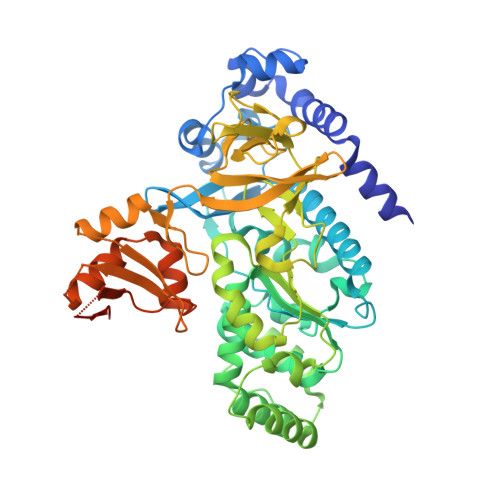Brassicaceae-specific Gretchen Hagen 3 acyl acid amido synthetases conjugate amino acids to chorismate, a precursor of aromatic amino acids and salicylic acid.
Holland, C.K., Westfall, C.S., Schaffer, J.E., De Santiago, A., Zubieta, C., Alvarez, S., Jez, J.M.(2019) J Biological Chem 294: 16855-16864
- PubMed: 31575658
- DOI: https://doi.org/10.1074/jbc.RA119.009949
- Primary Citation of Related Structures:
6OMS - PubMed Abstract:
To modulate responses to developmental or environmental cues, plants use Gretchen Hagen 3 (GH3) acyl acid amido synthetases to conjugate an amino acid to a plant hormone, a reaction that regulates free hormone concentration and downstream responses. The model plant Arabidopsis thaliana has 19 GH3 proteins, of which 8 have confirmed biochemical functions. One Brassicaceae-specific clade of GH3 proteins was predicted to use benzoate as a substrate and includes AtGH3.7 and AtGH3.12/PBS3. Previously identified as a 4-hydroxybenzoic acid-glutamate synthetase, AtGH3.12/PBS3 influences pathogen defense responses through salicylic acid. Recent work has shown that AtGH3.12/PBS3 uses isochorismate as a substrate, forming an isochorismate-glutamate conjugate that converts into salicylic acid. Here, we show that AtGH3.7 and AtGH3.12/PBS3 can also conjugate chorismate to cysteine and glutamate, which act as precursors to aromatic amino acids and salicylic acid, respectively. The X-ray crystal structure of AtGH3.12/PBS3 in complex with AMP and chorismate at 1.94 Å resolution, along with site-directed mutagenesis, revealed how the active site potentially accommodates this substrate. Examination of Arabidopsis knockout lines indicated that the gh3.7 mutants do not alter growth and showed no increased susceptibility to the pathogen Pseudomonas syringae , unlike gh3.12 mutants, which were more susceptible than WT plants, as was the gh3.7 / gh3.12 double mutant. The findings of our study suggest that GH3 proteins can use metabolic precursors of aromatic amino acids as substrates.
- Department of Biology, Washington University, St. Louis, Missouri 63130.
Organizational Affiliation:


















